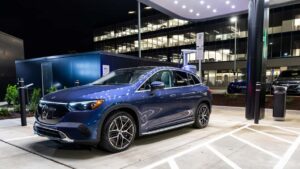Last major automaker to implement NACS connectors.
Stellantis has recently declared that its fleet of electric cars will soon be utilizing the SAE J3400 connector, commonly known as the North American Charging Standard (NACS), which is native to Tesla Superchargers. This decision makes Stellantis the newest and last major car manufacturer to make this change, following Mazda’s announcement last month and the VW Group’s decision in December.This decision means that Stellantis’ battery-electric vehicles will now be compatible with Tesla Superchargers, an increasingly popular charging option for electric car owners. The North American Charging Standard is also widely used in the United States and Canada, making it a convenient option for drivers in these regions.In addition to Stellantis, other major automakers such as Mazda and the VW Group have also made the switch to the NACS for their electric vehicles. This trend further solidifies the standardization and compatibility of the SAE J3400 connector in the industry, making it easier for electric car owners to charge their vehicles regardless of the brand or location.Stellantis’ adoption of the NACS is just one step towards their goal of increasing the accessibility and convenience of electric vehicles. By offering compatibility with Tesla Superchargers, Stellantis hopes to attract more potential buyers and boost
As per the car manufacturer, every Stellantis electric vehicle for the 2026 model year will come equipped with the NACS connector, granting users access to Tesla’s extensive network of Superchargers across the United States and Canada. This will include the highly anticipated all-electric version of the Dodge Charger, scheduled to make its debut in March. Additionally, the upcoming Chrysler electric vehicle, teased by the unveiling of the Halcyon EV concept today, will also feature this connector.



According to Ricardo Stamatti, Stellantis SVP of global energy & charging, “Customers are the ultimate beneficiaries when the industry comes together to support open standards. We are pleased to declare our support and implementation of the SAE J3400 connector, a significant achievement for all customers as we strive towards a future of accessible and uninterrupted charging.”
As part of the shift towards using NACS connectors, Stellantis will equip its upcoming EV models with CCS ports this year and in 2025. This includes popular vehicles like the Jeep Recon electric off-roader and the Ram 1500 REV. To accommodate this change, adapters will be offered for these models. The details of whether these adapters will come at no cost or not are still unclear, unlike Ford’s example where they offer complimentary NACS fast-charging adapters.



In addition to Tesla’s extensive Supercharger network, Stellantis electric vehicles (EVs) can also utilize a US-based charging network called Ionna. This network is the result of a major collaboration between seven automakers, including Stellantis, with the goal of rivaling Tesla’s Supercharger network in the coming years.Initially dubbed the “Unnamed Charging Project,” Ionna has now been officially named and aims to compete with Tesla by providing a widespread and reliable charging infrastructure for EVs across the country. Stellantis, along with fellow automakers, is investing heavily in this ambitious project that hopes to offer the convenience and ease of use similar to Tesla’s Superchargers.
Several major automotive companies, including BMW, General Motors, Honda, Hyundai, Kia, Mercedes-Benz, and Stellantis, have announced their plans to challenge Tesla Supercharger’s dominance as the leading charging network in North America by the end of the decade. In order to achieve this, Ionna will be implementing a total of 30,000 fast-charging stations in the United States and Canada, all equipped with both NACS and CCS plugs. This means that Stellantis EVs will now be able to charge at these stations without the need for an adapter. As Stellantis and other automakers make the transition to NACS, it is a mutually beneficial outcome for electric vehicle owners across America.








